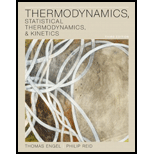
Interpretation:
The moles for an ideal gas with specific heat capacity at constant volume are transformed from the initial state to the final state with temperature and pressure range. The entropy change, enthalpy change and change in internal energy is to be stated.
Concept Introduction:
The entropy change for an ideal gas is given by the relation-
n: Moles of an ideal gas.
Cv: Specific Heat Capacity at constant volume.
R: Gas Constant.
T1: Initial Temperature.
T2: Final Temperature.
P1: Initial Pressure.
P2: Final Pressure.
Furthermore; the enthalpy change and change in internal energy for an ideal gas is given by these relations-
Cp: Specific Heat Capacity at constant pressure.
Want to see the full answer?
Check out a sample textbook solution
Chapter 5 Solutions
Thermodynamics, Statistical Thermodynamics, & Kinetics
- Determine the standard Gibbs free energy change, rG, for the reactions of liquid methanol, of CO(g), and ofethyne, C2H2(g), with oxygen gas to form gaseous carbondioxide and (if hydrogen is present) liquid water at298 K. Use your calculations to decide which of thesesubstances are kinetically stable and which are thermodynamically stable: CH3OH(), CO(g), C2H9(g), CO2(g),H2O().arrow_forwardCalculate the standard Gibbs free-energy change when SO3 forms from SO2 and O2 at 298 K. Why is sulfur trioxide an important substance to study? (Hint: What happens when it combines with water?)arrow_forwardWhat are the two ways that a final chemical state of a system can be more probable than its initial state?arrow_forward
- Billions of pounds of acetic acid are made each year, much of it by the reaction of methanol with carbon monoxide. (AssumeT= 298 K.) CH3OH() + CO(g) CH3COOH() (a) By calculating the standard Gibbs free energy change, rG, for this reaction, show that it is product-favored. (b) Determine the standard Gibbs free energy change, rG,for the reaction of acetic acid with oxygen to form gaseous carbon dioxide and liquid water. (c) Based on this result, is acetic acid thermodynamicallystable compared with CO2(g) and H2O()? (d) Is acetic acid kinetically stable compared with CO2(g)and H2O()?arrow_forwardAppendix J lists standard molar entropies S, not standard entropies of formation rS. Why is this possible forentropy but not for internal energy, enthalpy, or Gibbsfree energy?arrow_forwardBenzoic acid, C6H5COOH, is a common standard used in bomb calorimeters, which maintain a constant volume. If 1.20 g of benzoic acid gives off 31, 723 J of energy when burned in the presence of excess oxygen and in a water bath having a temperature of 24.6 C, calculate q, w, H, and U for the reaction.arrow_forward
- For tetrachloromethane, ΔvapH⦵ = 30.0 kJ mol−1. Calculate q, w, ΔH, and ΔU when 0.75 mol CCl4(l) is vaporized at 250 K and 1 bar.arrow_forwardIn a reversible, adiabatic expansion, compressed nitrogen gas (1 atm in 10.0 L, 170 °C, molar Cv,m = 20.8 J K-¹ mol-¹, and Cp,m = 29.1 J K-¹ mol-¹) expands to 27.0 L. Calculate Δq, n, Cv, Tfinal, Pfinal, Δw, ΔU, ΔH, ΔStot, ΔSsys, and ΔSsurr. Assume perfect gas behavior.arrow_forwardPE6.2 Calculate the standard molar Gibbs free energy change (AGran) at 298 K and at 400 K for the following reaction (the cyclotrimerization of ethene to benzene), assuming that all heat capacities are independent of temperature: 3 CH(g) → CoHo(g) +3 H2(g).arrow_forward
- For ethanol, ΔvapH⦵ = 43.5 kJ mol−1. Calculate q, w, ΔH, and ΔU when 1.75 mol C2H5OH(l) is vaporized at 260 K and 1 bar.arrow_forwardOne mole of a perfect gas contained in a 10-L vessel at 27 °C is permitted to expand freely into an evacuated vessel of 10-L capacity so that the final volume is 20 L. what is the change in entropy (in J K-¹) in the process? (The process q =0 because w = 0 for an expansion against a vacuum and that AU = 0 for an ideal gas.)arrow_forwardYou have a container with 1.10 moles of gaseous octane and you condense it isothermally and reversibly to liquid at 126°C. The standard enthalpy of vaporization of octane at 126°C is 39.1 (kJ *mol^−1). Find ΔH, q, w, and ΔU for this process. You can assume octane behaves as an ideal gas herearrow_forward
 Physical ChemistryChemistryISBN:9781133958437Author:Ball, David W. (david Warren), BAER, TomasPublisher:Wadsworth Cengage Learning,
Physical ChemistryChemistryISBN:9781133958437Author:Ball, David W. (david Warren), BAER, TomasPublisher:Wadsworth Cengage Learning, Chemistry: The Molecular ScienceChemistryISBN:9781285199047Author:John W. Moore, Conrad L. StanitskiPublisher:Cengage Learning
Chemistry: The Molecular ScienceChemistryISBN:9781285199047Author:John W. Moore, Conrad L. StanitskiPublisher:Cengage Learning Chemistry & Chemical ReactivityChemistryISBN:9781133949640Author:John C. Kotz, Paul M. Treichel, John Townsend, David TreichelPublisher:Cengage Learning
Chemistry & Chemical ReactivityChemistryISBN:9781133949640Author:John C. Kotz, Paul M. Treichel, John Townsend, David TreichelPublisher:Cengage Learning Chemistry: Principles and PracticeChemistryISBN:9780534420123Author:Daniel L. Reger, Scott R. Goode, David W. Ball, Edward MercerPublisher:Cengage Learning
Chemistry: Principles and PracticeChemistryISBN:9780534420123Author:Daniel L. Reger, Scott R. Goode, David W. Ball, Edward MercerPublisher:Cengage Learning Principles of Modern ChemistryChemistryISBN:9781305079113Author:David W. Oxtoby, H. Pat Gillis, Laurie J. ButlerPublisher:Cengage Learning
Principles of Modern ChemistryChemistryISBN:9781305079113Author:David W. Oxtoby, H. Pat Gillis, Laurie J. ButlerPublisher:Cengage Learning




